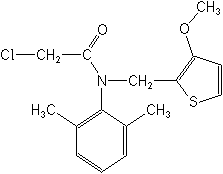-
Common NameThenylchlor
-
中文通用名噻吩草胺
-
IUPAC2-chloro-N-(3-methoxy-2-thenyl)-2′,6′-dimethylacetanilide
-
CAS2-chloro-N-(2,6-dimethylphenyl)-N-[(3-methoxy-2-thienyl)methyl]acetamide
-
CAS No.96491-05-3
-
Molecular FormulaC16H18ClNO2S
-
Molecular Structure
-
Category
-
ActivityHerbicide
Thenylchlor is suitable for pre-emergence or early post-emergence application to paddy fields and upland crops. It has residual activity lasting up to 30 days in cool conditions; in warm conditions this time is reduced. In paddy rice, optimum activity is achieved when the paddy water is at a depth of 3 cm. In trials, thenylchlor did not damage rice crops at up to three times the normal field rate. It has also shown good selectivity to legumes, spinach, cotton and sunflowers following pre-emergence treatment.
In field trials, the compound showed activity equal or greater than pretilachlor, at lower dose rates. -
CropUseCropUses:
rice
Rice
200-270 g ai/ha
-
PremixEmulsifiable concentrate, wettable powder, granule. Premix Parters: azoxystrobin fludioxonil metalaxyl-M; lambda-cyhalothrin; difenoconazole; difenoconazole fludioxonil metalaxyl-M; fludioxonil; fludioxonil metalaxyl-M; metalaxyl-M;
Type
AI concn
Granule (GR)
0.9% (w/w)
Suspension concentrate (SC)
4% (w/v)
-
Physical PropertiesMolecular weight:323.8; Physical form:White solid with a slight, sulfurous odour. Density:1.19 (25 °C); Composition:Tech. is ×95% pure. Melting point:72-74 °C; Flash point:224 °C; Vapour pressure:2.8 × 10-2 mPa (25 °C); Partition coefficient(n-octanol and water):logP = 3.53 (25 °C); Solubility:In water 11 ppm (20 °C).; Stability:Decomposes at 260 °C. Decomposed by u.v. irradiation (400 nm, 8 h). Stable to acid and base in range pH 3-8.;
-
ToxicologyOral:Acute oral LD50 for rats and mice >5000 mg/kg. Percutaneous:Acute percutaneous LD50 for rats >2000 mg/kg. Inhalation:LC50 (4 h) for rats >5.67 mg/l. Phytotoxicity:No crop (rice) injury after post-planting treatment.
-
Environmental ProfileEcotoxicology:?
Bees: LD50 (96 h) >100 μg/bee.Birds: LD50 for bobwhite quail >2000 mg/ kg.Daphnia: LC50 (3 h) >100 ppm.Fish: TLm (48 h) for carp 0.76 ppm.Worms:LD50 (14 d) for earthworms >1000 ppm.?
Environmental fate:?
Soil: Koc 480-2846.
Bobwhite quail
LD50 >2,000 mg/kg
Carp[48 hrs]
LC50 0.76 mg/litre
Fate in soil:
Thenylchlor is slightly mobile in soil. Mobility is greatest in sandy loam soils. Thenylchlor is rapidly degraded in soil. -
Transport InformationHazard Class:O (Obsolete as pesticide, not classified)
Porduct NewsMore
Bayer develops alternative to glyphosate herbicide
Colombia’s Constitutional Court bans chlorpyrifos
ADAMA Canada moves forward with lambda-cyhalothrin sales for 2023
Mexico: Import of glyphosate drops from 16,500 tons to 8,200 tons
Glyphosate prices drop 30% in Argentina
One year extension of EU glyphosate approval failed to pass in the latest meeting
Palmer amaranth in two southern U.S. states now resistant to S-metolachlor

 0
0 Subscribe
Subscribe
